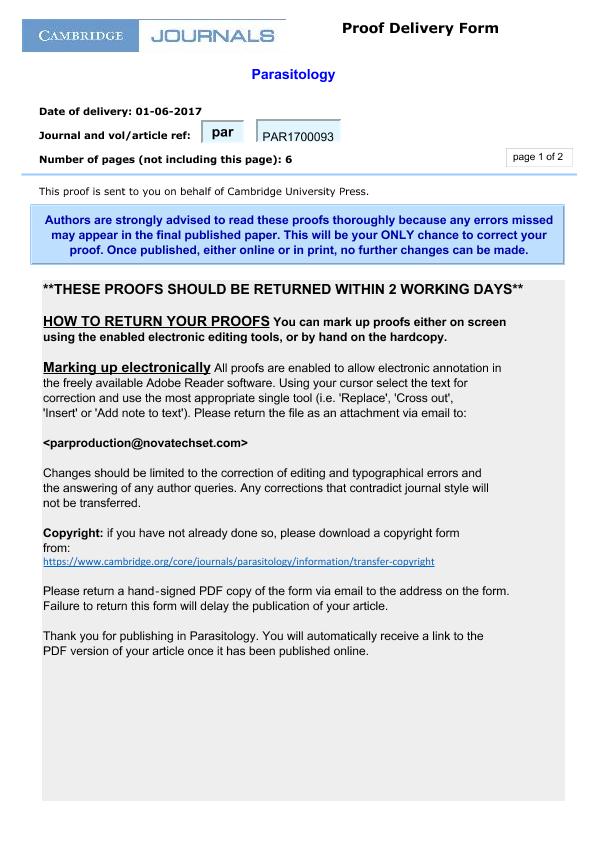Mostrar el registro sencillo del ítem
dc.contributor.author
Taglioretti, Verónica

dc.contributor.author
Fugassa, Martín Horacio

dc.contributor.author
Rindel, Diego Damián

dc.contributor.author
Sardella, Norma Haydee

dc.date.available
2018-11-20T16:23:11Z
dc.date.issued
2017-11
dc.identifier.citation
Taglioretti, Verónica; Fugassa, Martín Horacio; Rindel, Diego Damián; Sardella, Norma Haydee; New parasitological findings for pre-Hispanic camelids; Cambridge University Press; Parasitology; 144; 13; 11-2017; 1763-1768
dc.identifier.issn
0031-1820
dc.identifier.uri
http://hdl.handle.net/11336/64734
dc.description.abstract
SUMMARY Paleoparasitological examination provides information of parasite-host associations in the past, shedding light on the geographical origin of some parasites, on the possible dispersal routes and on some of the processes that modelled the parasitic communities. The aim of the present study was to examine parasite remains present in camelid coprolites collected from the archaeological site Alero Destacamento Guardaparque, Patagonia and to discuss the paleoparasitological findings in a biogeographical and paleoecological context. Coprolites were collected from different stratified layers dating from middle to late Holocene, a period covering approximately 7000 years. Paleoparasitological examination revealed the presence of eggs attributed to Lamanema chavezi or Nematodirus lamae, Nematodirus spathiger, Dictyocaulus sp., eggs of two unidentified capillariids, Strongylus-Type eggs and oocysts of Eimeria macusaniensis. Enteric parasites of camelids had not changed significantly during the Holocene up to the entry of introduced livestock, although environmental conditions fluctuated greatly throughout this period, indicating the stability of these associations over time. This is the first finding of N. spathiger and Dictyocaulus sp. in paleoparasitological record and their presence are associated with the interaction of camelids with introduced livestock, which likely allowed parasite host switching. In the present study, the zoonotic importance of parasites of camelids is also discussed.
dc.format
application/pdf
dc.language.iso
eng
dc.publisher
Cambridge University Press

dc.rights
info:eu-repo/semantics/openAccess
dc.rights.uri
https://creativecommons.org/licenses/by-nc-sa/2.5/ar/
dc.subject
Camelids
dc.subject
Holocene
dc.subject
Host Switching
dc.subject
Introduced Livestock
dc.subject
Paleoparasitology
dc.subject.classification
Otras Ciencias Biológicas

dc.subject.classification
Ciencias Biológicas

dc.subject.classification
CIENCIAS NATURALES Y EXACTAS

dc.title
New parasitological findings for pre-Hispanic camelids
dc.type
info:eu-repo/semantics/article
dc.type
info:ar-repo/semantics/artículo
dc.type
info:eu-repo/semantics/publishedVersion
dc.date.updated
2018-10-23T14:10:59Z
dc.identifier.eissn
1469-8161
dc.journal.volume
144
dc.journal.number
13
dc.journal.pagination
1763-1768
dc.journal.pais
Reino Unido

dc.journal.ciudad
Cambridge
dc.description.fil
Fil: Taglioretti, Verónica. Consejo Nacional de Investigaciones Científicas y Técnicas; Argentina. Universidad Nacional de Mar del Plata. Facultad de Ciencias Exactas y Naturales; Argentina
dc.description.fil
Fil: Fugassa, Martín Horacio. Consejo Nacional de Investigaciones Científicas y Técnicas; Argentina. Universidad Nacional de Mar del Plata. Facultad de Ciencias Exactas y Naturales; Argentina
dc.description.fil
Fil: Rindel, Diego Damián. Consejo Nacional de Investigaciones Científicas y Técnicas; Argentina. Universidad de Buenos Aires; Argentina
dc.description.fil
Fil: Sardella, Norma Haydee. Consejo Nacional de Investigaciones Científicas y Técnicas; Argentina. Universidad Nacional de Mar del Plata. Facultad de Ciencias Exactas y Naturales; Argentina
dc.journal.title
Parasitology

dc.relation.alternativeid
info:eu-repo/semantics/altIdentifier/doi/https://dx.doi.org/10.1017/S0031182017000932
dc.relation.alternativeid
info:eu-repo/semantics/altIdentifier/url/https://www.cambridge.org/core/journals/parasitology/article/new-parasitological-findings-for-prehispanic-camelids/94A7825207E2C309AF89B2D2B6C2EB8D
Archivos asociados
